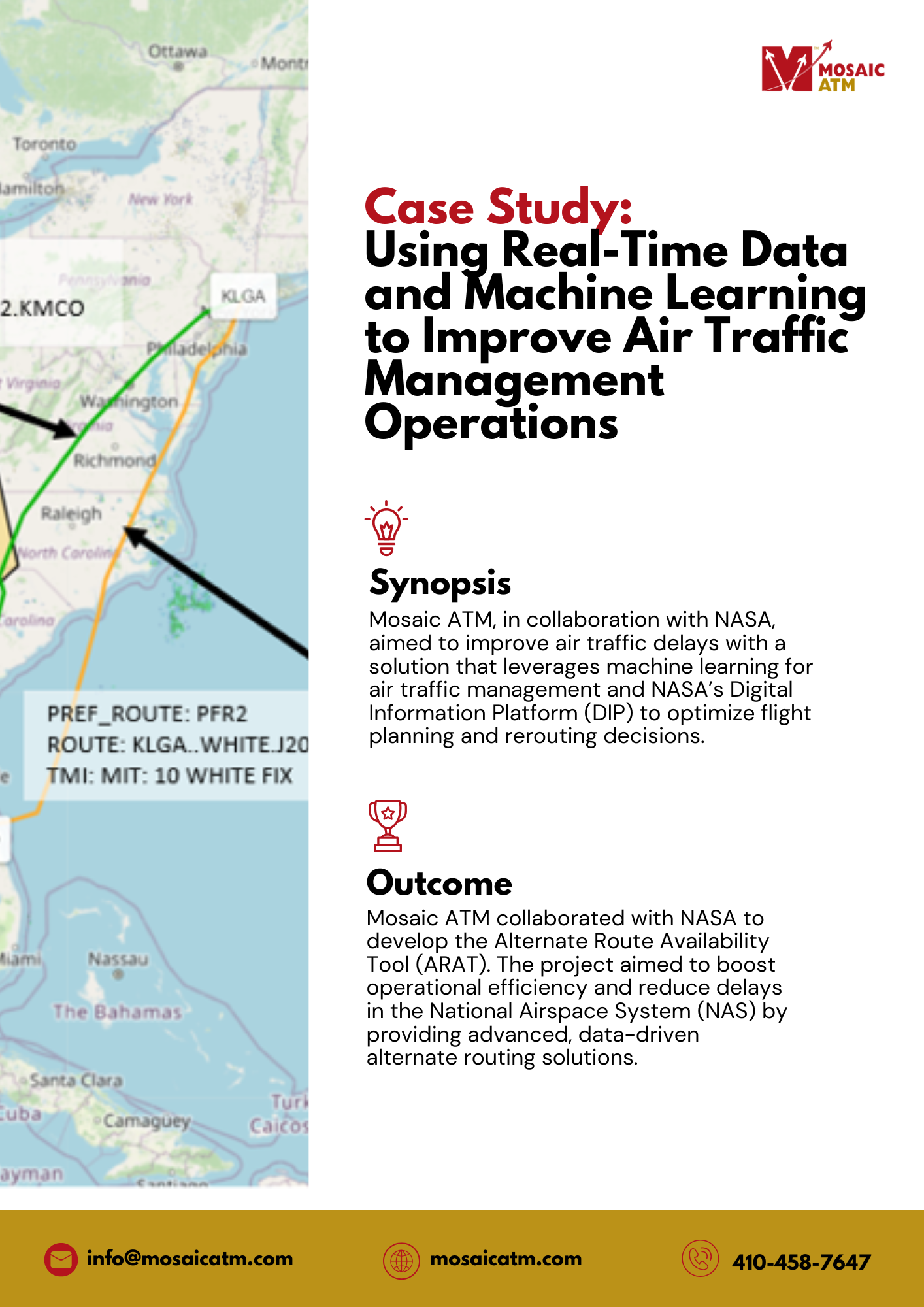
Take Our Content to Go
Problem
Air traffic delays—70% of which are caused by weather—pose a significant challenge to the aviation industry, leading to financial losses, inefficiencies, and environmental impacts. Existing tools for flight planning often struggle to provide actionable insights, especially when dealing with the complexities of TMIs and real-time weather constraints. Mosaic ATM, in collaboration with NASA, aimed to bridge this gap with a solution that leverages machine learning for air traffic management and NASA’s Digital Information Platform (DIP) to optimize flight planning and rerouting decisions.
Solution
Building on 20+ years of expertise in air traffic management and system optimization, Mosaic ATM collaborated with NASA to develop the Alternate Route Availability Tool (ARAT). The project aimed to boost operational efficiency and reduce delays in the National Airspace System (NAS) by providing advanced, data-driven alternate routing solutions.
The project consisted of two phases. Phase I laid the foundational infrastructure, integrating ARAT with NASA’s Digital Information Platform (DIP) and establishing its core functionalities. Phase II focused on expanding ARAT’s features, refining its route scoring models, and integrating it with NASA’s Collaborative Digital Departure Re-routing (CDDR) Tool. By splitting the work into two phases, Mosaic’s team ensured steady progress while addressing the complexities of integrating multiple datasets and enhancing system scalability.
Phase I: Laying the Groundwork for Machine Learning for Air Traffic
In Phase I, Mosaic focused on integrating ARAT with NASA’s DIP, leveraging the NAS TMI Service to access real-time information about TMIs and weather conditions. This integration laid the foundation for ARAT to provide actionable insights for airlines and air traffic controllers. The team also developed robust parsing rules to interpret TMIs specific to critical facilities like C90 TRACON, enhancing ARAT’s ability to deliver accurate and relevant data.
The collaboration emphasized the importance of a unified platform for collaborative decision-making. ARAT created a framework for faster and more efficient rerouting strategies by bridging the gap between air traffic controllers and airlines. These initial achievements positioned ARAT as a vital tool for addressing the challenges of weather-induced delays and operational inefficiencies in the NAS.
Phase II: Expanding Capabilities for Machine Learning for Air Traffic
Building on the success of Phase I, Phase II expanded ARAT’s functionality and integrated it more deeply with NASA’s ecosystem. A key milestone was registering ARAT as a service on NASA’s DIP, a process that required Mosaic to transition ARAT’s infrastructure to a scalable and secure AWS environment. This move not only improved system performance but also ensured compliance with NASA’s integration standards.
ARAT’s integration with NASA’s CDDR tool represented another significant advancement. Mosaic implemented an additional API endpoint, allowing ARAT to provide weather-specific data independently of the NAS TMI Service. This adaptation aligned with the CDDR tool’s requirements and highlighted ARAT’s flexibility in serving diverse data needs. The collaboration also explored mockups for integrating ARAT’s weather data into CDDR’s interface, enhancing its usability for air traffic controllers.
Another critical enhancement in Phase II was the expansion of ARAT’s data sources. Mosaic added features to display comprehensive weather phenomena from the Aviation Weather Center, supporting both operational use and commercialization efforts. The team also developed a historical data playback capability, enabling ARAT to analyze past TMIs and weather conditions. This capability proved invaluable for training route scoring models and identifying patterns that could inform future operational decisions.
To further improve ARAT’s predictive capabilities, Mosaic developed an initial delay estimation model and integrated it into the system. This model, supported by six months of processed historical data, provided critical insights into route efficiency and delay mitigation. Alongside this, Mosaic refined its data pipelines to address discrepancies in historical TMI parsing, ensuring the reliability and accuracy of its training datasets.
Results and Impact
The implementation of ARAT brought tangible benefits to the NAS, significantly enhancing the efficiency of flight planning and air traffic management. Airlines and air traffic controllers can potentially reduce delays, driven by ARAT’s predictive models and real-time data integration. The tool’s ability to identify and recommend optimal alternate routes translated into measurable fuel savings and reduced emissions, aligning with industry sustainability goals.
ARAT’s modular design and AWS deployment ensured scalability, allowing it to adapt to the evolving needs of the aviation industry. By improving data interpretation and fostering collaboration between stakeholders, ARAT empowered decision-makers with actionable insights, transforming how air traffic challenges were addressed.
Conclusion
The Alternate Route Availability Tool exemplifies the power of data-driven solutions in addressing complex challenges within the aviation industry. Through its phased approach, Mosaic ATM successfully delivered a tool that not only enhanced operational efficiency but also set a new standard for collaborative decision-making in air traffic management. By integrating real-time data, predictive modeling, and user-friendly interfaces, ARAT has proven to be an invaluable asset for airlines, air taxi operators, and air traffic controllers.
As Mosaic continues to refine ARAT, the focus remains on expanding its capabilities, advancing machine learning for air traffic management models, and broadening its integration with other NAS systems. The success of ARAT underscores the potential for innovation to drive meaningful improvements in aviation, paving the way for a smarter, more efficient future in air traffic management.


